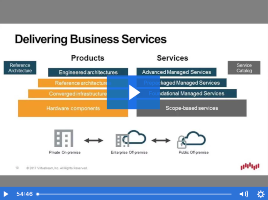Deliver Competitive Advantage via Cloud-Based SAP Workloads
Identifying the steps that you can take to ensure the success of your cloud initiatives after the initial transformation
By Alex Soto, Editor, SAPinsider
Organizations today are transitioning their SAP workloads to the cloud to achieve greater flexibility and scalability. Benefits of this move include increased efficiency, improved productivity beyond the initial transition, and the ability to deploy applications more rapidly than on-premise infrastructure supports.
While the underlying thread that enables successful cloud adoption is technology, digital transformation requires cooperation between leaders across business and technology functions.
Explore related questions
Defining what infrastructure will be needed is primarily driven by business-specific programs. For example, when building a business case to move SAP S/4HANA workloads to the cloud, what performance, availability, and resilience are required?
SAPinsider recently had the opportunity to sit with Chris Ceska, an SAP Solutions Leader in the Azure Applications and Infrastructure Global Black Belt Team at Microsoft, Damien Johnson, Chief Architect for the Global Customer Success Organization, SAP, and Ramesh J. Chougule, SAP Cloud and Digital Leader at Infosys.
According to this group of experts, key discussions that organizations should have around moving SAP workloads to the cloud include business leadership, complexity, and consumer trends. In addition, infrastructure, integration, cost improvement, and sustainability must also be considered.
Connecting Technology with the Business Vision
When considering a cloud transition the question is: What do organizations need to bring all the technology requirements together to deliver expected business outcomes?
Establishing a digital transformation program means that business and technical leaders must align on cloud adoption and go beyond just technology requirements. But it is up to the business to determine the path forward.
Chougule explains that business leaders, such as chief marketing officers, are responsible for what their function will look like in two years. Their business perspective will help determine the prerequisites of how a technology should be used to deliver business value.
The feedback from the business is then shared back to the CIOs and CTOs of an organization. It is in this layer of leadership that technical and architectural details will be hashed out.
But organizations should also consider the people aspect to digital transformation. According to Johnson, organizational change management matters just as much today as traditional change management.
“When you’re looking at the big picture, you are effectively working with and enacting across a larger footprint,” he says. “It’s not just the traditional SAP team that the involvement expands across. There is more than just getting the software deployed and making sure people are being trained.”
He explains that the whole aspect of the business-driven process in digital transformation is just coming to the forefront. And it can be a complex process. Therefore, business leaders will likely need guidance from technical leaders to determine the requirements of a solution.
Managing Complexity and Consumer Trends
Data governance coupled with organizational change management has become essential components for dealing with complexity. If these aren’t included in your project, an organization can end up with an unwieldy environment, according to Ceska. “You can actually be doing more harm than good in the end,” he says.
Macro-economic changes, such as business model evolution, can make an already complex process even more challenging to handle. As businesses reevaluate their technology infrastructure, that long-term view is vital in determining how the cloud can help organizations build up resiliency ahead of forces beyond the control of a business, like the disruptions caused by the COVID-19 pandemic.
“But you need to ensure that things are sufficiently open that customers experience the benefits,” Ceska says.
For example, a central point in decisions about technology infrastructure is digital consumerism and how consumer behavior has changed over time, according to Chougule.
Modernizing Infrastructure
Whether an organization is moving SAP workloads or has already done so, the focus becomes how to transition technical personnel from maintaining legacy systems to building out skillsets to maximize the value of Azure inside their organization.
In terms of the value the cloud delivers from a technical standpoint, CIOs and CTOs worry less about security as the business scales and evolves because moving to the cloud helps overcome these issues.
Ceska explains that not having to set up infrastructure for monitoring, security, or backup is a key benefit of an Azure service. “You’re able to get through that first wave of getting implemented, and then it opens up opportunities,” he says.
No longer having to manage an infrastructure layer reduces administrative overhead and can even reduce redundancy in the application layer itself.
According to Johnson, it also provides the flexibility to redeploy resources toward innovation and address real business challenges, such as improving operational processes.
Frictionless Integration
However, the digital transformation journey is not one-size-fits-all. Each organization will face different interactions when integrating internal systems with the external data elements on the cloud.
Creating a frictionless enterprise is a key for organizations moving their SAP workloads to the cloud to boost productivity, according to Chougule.
He uses an example of sales agents creating orders without having to log onto an SAP solution. These kinds of business transactions are made possible by integrating conversational AI and Microsoft Teams, resulting in increased productivity.
In another example, he explains how this type of integration simplified his own processes. He received an email requesting a response to a question about performance appraisals: “Do we want to update the goals, or retain them?” He logged into Microsoft teams and answered the question while on the backend SAP closed the appraisal. There was no need to directly connect to an SAP system.
“It’s as simple as that,” Chougule says. “You can see huge amount of productivity improvement in the day-to-day work and activities all across the spectrum of businesses.”
“The fact that both platforms are being leveraged from an interaction point, as well as acting as a transaction point, is one of the biggest advantages of running SAP on Azure,” says Johnson.
This type of frictionless integration made possible by running SAP workloads on Azure creates a singular data fabric that allows organizations to extract business value without wholesale movement of data from one platform to the other, according to Johnson.
KPIs, Cost Improvement, and Sustainability
When creating a business case for moving SAP workloads to Azure, it is essential to look at KPIs across various functions.
Determining the financial and productivity benefit of the effort means looking at how things operate at the micro-level.
“For example, when we analyze order-to-cash, we clearly look at the gas bill rate and the delivery time,” says Ceska. “We also may look at how much time it takes to close the period.”
These types of questions help determine opportunities for improvement at the operational micro-level. Having this information is necessary to define KPIs and determine how moving SAP to the cloud can help meet business objectives.
Traditionally, KPIs and metrics revolve around improvement and cost savings. For example: How can leveraging new technologies around cloud adoption open opportunities to reduce the cost of maintaining aging infrastructures and databases?
“Driving this adoption, or modernization of SAP for that matter, one clear strategy is cost takeout,” Chougule says.
He explains that customers often pay large sums of money to maintain underutilized legacy hardware. According to Chougule, the option to leverage a public cloud, like Azure, pays off for organizations as they scale up to meet business requirements.
Chougule highlights that moving SAP workloads to the cloud has gained momentum because customers can see an immediate cost-savings benefit.
In addition to cost savings, sustainability is a new type of KPI increasingly added to the mix of many organizations looking to reap the business rewards of digital transformation.
Ceska says he often gets the following question from customers. “How do I reduce cost, and how do I do it in the most sustainable fashion?”
This connects back to the idea that changing consumer buying patterns are a big business driver in technology decisions in digital transformation programs. Customers are looking for sustainable products, so companies want to meet that need by improving sustainability in their procurement, distribution, and other business processes.
“More and more customers are asking about sustainability,” Johnson says. He explains that in the past, it was all about the cheapest way to get material to a consumer. “Now, they want multiple routes, not necessarily the cheapest and fastest, but the most sustainable,” he says.
No Need to Reinvent the Wheel
Among the business benefits of moving to a public cloud provider is operating with more flexibility and scalability. Additionally, the cloud environment provides a consumption-based model that enables organizations to modernize their data state while keeping an eye on operational expenditures.
For many organizations, moving to SAP S/4HANA has become critical because of the business value that it brings. When done in combination with cloud transformation, this can free up resources for innovation projects to drive further business value.
“Customers are looking at both the business tier and technology tier to provide innovation, scale, and speed,” says Ceska. “Running SAP on Azure can help integrate technology at the business process level.”
The low code aspect of cloud technology is a further added benefit, he says. For example, he highlights the ease of accessing sentiment analysis, leveraging speech text analysis capabilities from the Azure platform, and hooking that directly into the SAP Customer Experience portfolio.
But for this sort of transition to be successful, the focus must be on clarifying the business value and expectations that the technology will deliver.
“It’s not only about moving running SAP S/4HANA in the cloud. It’s also about modernizing the data state to deliver business value,” Chougule says.
For example, a supply chain organization preparing to move data to the cloud from traditional on-premise applications needs to think about how the migration can optimize their supply chain performance and provide better customer insights.
“An interesting part about this journey to the cloud is the business innovation layer residing in SAP S/4HANA,” says Johnson. “When you’re ready to flip the switch and move over to running a fully digital SAP S/4HANA world, all the work that you’ve done with regard to data platform integrations carries forward. You don’t have to reinvent the wheel.”
What does this mean for SAPinsiders?
Leveraging cloud-based solutions can not only bring flexibility, scalability, and increased resiliency from a technical standpoint, but it can create the opportunities needed to drive significant business process transformation. But how should SAPinsiders make the most of cloud transformations that they undertake beyond the initial deployment?
- Ensure that your cloud transformation is directly connected to your business vision. Many organizations have moved workloads to the cloud so that they can leverage the infrastructure improvements that it brings while reducing the cost of internal IT. But only when the business vision is connected directly to technological change can organizations maximize the benefits that a cloud transformation brings. Ensure that your business leaders are involved in laying out the roadmap for their own organizations as your technology leaders plan infrastructure changes.
- Leverage the services that your cloud provider offers to provide additional benefits. Each cloud provider has services that you can use to enhance your SAP solutions. Ensure that you not only understand what these are, but that you leverage the opportunities that these present in order to provide additional value. An example of this is the way in which SAP applications integrate with conversational AI and Microsoft Teams to increase productivity. Each cloud provider has different services that can be used to enhance your SAP solutions, so ensure that you not only explore but leverage these.
- Implement KPIs that will help you measure and track the success of your cloud initiatives. While flexibility and scalability is a key factor in organizations starting cloud initiatives, it is important that you determine how you will measure success when building your business case. Many organizations expect reduced IT costs, faster deployment of applications, or increased operational efficiencies, but you should map and understand which KPIs you will use and what they mean to your organization if you are to ensure success.
About Microsoft
Microsoft enables digital transformation and supports organizations moving to cloud-based technologies and infrastructure. They partner closely with SAP to help customers accelerate their cloud journey.








